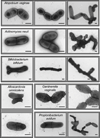Gram-Positive Uropathogens, Polymicrobial Urinary Tract Infection, and the Emerging Microbiota of the Urinary Tract
- PMID: 27227294
- PMCID: PMC4888879
- DOI: 10.1128/microbiolspec.UTI-0012-2012
Gram-Positive Uropathogens, Polymicrobial Urinary Tract Infection, and the Emerging Microbiota of the Urinary Tract
Abstract
Gram-positive bacteria are a common cause of urinary-tract infection (UTI), particularly among individuals who are elderly, pregnant, or who have other risk factors for UTI. Here we review the epidemiology, virulence mechanisms, and host response to the most frequently isolated Gram-positive uropathogens: Staphylococcus saprophyticus, Enterococcus faecalis, and Streptococcus agalactiae. We also review several emerging, rare, misclassified, and otherwise underreported Gram-positive pathogens of the urinary tract including Aerococcus, Corynebacterium, Actinobaculum, and Gardnerella. The literature strongly suggests that urologic diseases involving Gram-positive bacteria may be easily overlooked due to limited culture-based assays typically utilized for urine in hospital microbiology laboratories. Some UTIs are polymicrobial in nature, often involving one or more Gram-positive bacteria. We herein review the risk factors and recent evidence for mechanisms of bacterial synergy in experimental models of polymicrobial UTI. Recent experimental data has demonstrated that, despite being cleared quickly from the bladder, some Gram-positive bacteria can impact pathogenic outcomes of co-infecting organisms. When taken together, the available evidence argues that Gram-positive bacteria are important uropathogens in their own right, but that some can be easily overlooked because they are missed by routine diagnostic methods. Finally, a growing body of evidence demonstrates that a surprising variety of fastidious Gram-positive bacteria may either reside in or be regularly exposed to the urinary tract and further suggests that their presence is widespread among women, as well as men. Experimental studies in this area are needed; however, there is a growing appreciation that the composition of bacteria found in the bladder could be a potentially important determinant in urologic disease, including susceptibility to UTI.
Figures



References
-
- Hooton TM. Clinical practice. Uncomplicated urinary tract infection. N Engl J Med. 2012;366:1028–1037. - PubMed
-
- Schroeder AR, Chang PW, Shen MW, Biondi EA, Greenhow TL. Diagnostic accuracy of the urinalysis for urinary tract infection in infants<3 months of age. Pediatrics. 2015;135:965–971. - PubMed
-
- Clyne M. Paediatrics: dipstick adequate for febrile UTI test. Nat Rev Urol. 2014;11:304. - PubMed
-
- Jido TA. Urinary tract infections in pregnancy: evaluation of diagnostic framework. Saudi J Kidney Dis Transpl. 2014;25:85–90. - PubMed
Publication types
MeSH terms
Grants and funding
LinkOut - more resources
Full Text Sources
Other Literature Sources
Medical
Molecular Biology Databases

